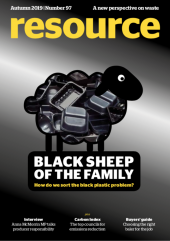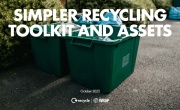Balancing our approach to packaging reform
Enthusiasm to simplify the recycling instructions on packaging risks throwing the baby out with the bathwater, writes Simon Weston, Director of Raw Materials for the Confederation of Paper Industries
The publication of responses to the government’s recent consultations on resources and waste shines a light on four core aims that must be addressed if we are going to improve resource efficiency through better recycling.
Firstly, to create order in household collection systems by standardising materials and the way they are collected. Secondly, to develop key recycling infrastructure and, by providing investment, nurture it as a strategic asset. Thirdly, to engage the public in the process of circularity and sustainability to help people understand the relevance and importance of recycling for future generations.
Finally, the variety of materials coming into the recycling chain needs to be rationalised so that infrastructure can valorise it in the most efficient way. This needs to accommodate and not stifle the development of new materials and reprocessing technologies, strengthening one of the key purposes of packaging: to protect goods through the supply chain.

The Confederation of Paper Industries (CPI) Recyclability Guidelines, published in February, are a contribution towards the last of these aims and offer a broad and aspirational summary of what the high volume, standard UK recycling paper mills would prefer to receive as feedstock. This document is not focused at the public, but at packaging designers and specifiers in an attempt to stimulate thought about how some existing packaging formats could be re-engineered to make them more easily reprocessed in the future. For the avoidance of doubt, all paper and board packaging is recyclable, but some formats are less readily reprocessed than others and may require specialist treatment or separate collection. The ambition of the guidelines is to optimise packaging design and reduce waste in the system.
Against the backdrop of heightened public interest in the impact of packaging on the environment, these guidelines have been broadly welcomed, attracting interest from as far afield as Australia and Hong Kong, and from Europe, especially Germany. It is also fair to say some businesses that may be impacted have expressed reservations about elements of the guidance.
It is, therefore, concerning that the purpose of the CPI document is being usurped and, in some cases, misrepresented in an apparent rush to create a binary marking system for consumer packaging, with potential unintended risks for the environment.
 This article was taken from Issue 97
This article was taken from Issue 97One of the key tenets of the guidelines is an aspiration to reduce the amount of plastic in fibre-based composites to five per cent or below. This is entirely congruent with general concerns about the environmental impact of single-use packaging and will help to reduce the amount of unrecoverable waste passing through paper mills. However, the paper industry also accepts that achieving this aspiration is a stretch and may take time and technological development, and even then, for some applications it may not be achievable. So, the guidance isn’t saying that in future paper-based composites with more than five per cent plastic will be considered unrecyclable; it may, however, propose that some formats should be collected or presented separately for recycling, as is currently the case with beverage cartons. A nuanced approach is necessary to achieve the best environmental outcome.
The government consultations offer a once in a lifetime opportunity to change recycling systems and habits and to recalibrate packaging design. This is the start of a journey that could transform the packaging of the future. The government is pushing for a simplified marking system for consumer goods, but this
needs to be done carefully if unintended consequences are to be avoided. It is important that a rush to binary labelling doesn’t result in misleading and inaccurate interpretations of industry guidelines and longer-term damage to recycling performance, sustainability and circularity.






